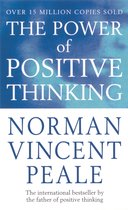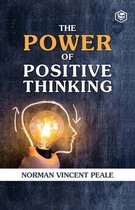THE POWER OF POSITIVE THINKING Ebook Tooltip Ebooks kunnen worden gelezen op uw computer en op daarvoor geschikte e-readers. A Practical Guide To Mastering The Problems Of Everyday Living
Afbeeldingen
Sla de afbeeldingen overArtikel vergelijken
- Engels
- E-book
- 1230003047033
- 24 januari 2019
- Epub zonder kopieerbeveiliging (DRM)
Dr. Norman Vincent Peale
(Bron: Wikipedia. Beschikbaar onder de licentie Creative Commons Naamsvermelding/Gelijk delen.)"
Samenvatting
THE POWER OF POSITIVE THINKING
A Practical Guide To Mastering The Problems Of Everyday Living
By
Dr. Norman Vincent Peale
Synopsis
The Power of Positive Thinking is a self-help book by Norman Vincent Peale, originally published in 1952. It makes use of positive case histories and practical instructions to propose the method of positive thinking. Peale's work describes how to achieve a permanent and optimistic attitude through unending positive conscious thought, usually through affirmations or visualizations. Peale writes that such techniques will give the reader a higher satisfaction and quality of life. Though negatively reviewed by scholars and health experts, The Power of Positive Thinking became popular in public opinion when first published and continues in popularity today.
Peale begins by stating ten rules for “overcoming inadequacy attitudes and learning to practice faith”.[4] The rules include the following: picture yourself as succeeding, think a positive thought to drown out a negative thought, minimize obstacles, do not attempt to copy others, repeat “If God be for us, who can be against us?” ten times every day, work with a counselor, repeat “I can do all things through Christ which strengtheneth me” ten times every day, develop a strong self-respect, affirm that you are in God's hands, and believe that you receive power from God.[4] The next chapter describes the importance of creating a peaceful mind, which can be done through inspirational reading, clearing one's mind, or visualization. Peale continues with how to obtain consistent energy, saying that “God is the source of all energy”.[4] The mind controls how the body feels; thus, letting go of negative energy and emotions will give infinite energy through God. Next, Peale speaks of the healing power of prayer, and how it will heal physical and emotional problems that arise from negative circumstances. In chapters five and six, Peale asserts that happiness is created by choice and that worrying only inhibits it and should be stopped. The next step in thinking positively is to always believe in success and not to believe in defeat because most obstacles are “mental in character”.[4] Habitual worrying is the next obstacle to overcome through emptying the mind and positive affirmations. Peale then states that asking God for help can solve one's personal problems and physically and emotionally heal them.
In chapter twelve, Peale states that letting go of anger and embracing a sense of calm can help with physical illnesses, such as eczema.[4] Next, Peale states that letting positive thoughts in can change one's outlook on life drastically and that practicing relaxation through God's help will lead to a content life. Chapter fifteen gives concrete examples on how to get others to like you, including the following: remember names, praise others generously, become a people person, and resolve problems calmly as soon as they appear. Peale then continues with how to overcome heartache - through prayer, meditation, social interactions, and keeping a daily routine. The final chapter restates the importance of reaching out to a Higher Power for help in living a peaceful, positive life. Peale ends The Power of Positive Thinking with an epilogue encouraging readers to follow his techniques and live more fulfilled lives. Peale writes, “I pray for you. God will help you — so believe and live successfully
About the author
Norman Vincent Peale, born in 1898 in southwestern Ohio, graduated from Ohio Wesleyan University and later received his bachelor's and master's degrees in sacred theology from Boston University's School of Theology. Peale then attended Syracuse University where he received a doctor of divinity degree. After serving 10 years as a Methodist clergyman in New York, Peale became the pastor of New York City's Marble Collegiate Church where he stayed for 52 years, until his retirement in 1984. Throughout his career as a pastor, Peale wrote over 40 books, became a sought-after motivational speaker, started weekly radio and television shows, organized the American Foundation of Religion and Psychiatry, and co-founded the spiritual newsletter Guideposts with his wife, Ruth Stafford Peale
Publication information
The Power of Positive Thinking was published in October 1952 and continues to be Peale's most widely read work. It lived on the New York Time's best-sellers list for 186 weeks, 48 of which were spent in the No. 1 nonfiction spot.[3] The book sold more than 5 million copies worldwide[4] — 2.5 million from 1952 to 1956[5] — and was eventually translated into over 40 languages.[6] Other books published by Peale around 1952 include The Art of Real Happiness, published in 1950, and Inspiring Messages for Daily Living, published in 1955.[7] The Power of Positive Thinking appeared at a time when Christian church attendance was drastically increasing, national views of spirituality, individuality, and religion were shifting, and the Cold War was a growing concern for many Americans.[5] These factors, as well as Peale's growing popularity as a motivational public figure and the book's clear prose, propelled The Power of Positive Thinking into a self-help book still popular today.
File information
File size (Digital) (660KB)
Books (1)
Page count (8.5x11) (252)
Word count (89,299)
Productspecificaties
Inhoud
- Taal
- en
- Bindwijze
- E-book
- Oorspronkelijke releasedatum
- 24 januari 2019
- Ebook Formaat
- Epub zonder kopieerbeveiliging (DRM)
Betrokkenen
- Hoofdauteur
- Dr. Norman Vincent Peale
- Tweede Auteur
- James M. Brand
- Hoofduitgeverij
- Zreads
Lees mogelijkheden
- Lees dit ebook op
- Android (smartphone en tablet) | Kobo e-reader | Desktop (Mac en Windows) | iOS (smartphone en tablet) | Windows (smartphone en tablet)
Overige kenmerken
- Studieboek
- Nee
EAN
- EAN
- 1230003047033
Kies gewenste uitvoering
Prijsinformatie en bestellen
De prijs van dit product is 4 euro en 90 cent.- E-book is direct beschikbaar na aankoop
- E-books lezen is voordelig
- Dag en nacht klantenservice
- Veilig betalen
Vaak samen gekocht
Rapporteer dit artikel
Je wilt melding doen van illegale inhoud over dit artikel:
- Ik wil melding doen als klant
- Ik wil melding doen als autoriteit of trusted flagger
- Ik wil melding doen als partner
- Ik wil melding doen als merkhouder
Geen klant, autoriteit, trusted flagger, merkhouder of partner? Gebruik dan onderstaande link om melding te doen.








